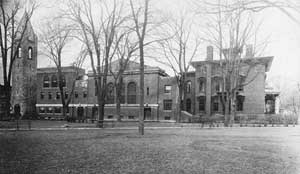
Le comté de Tompkins est divisé par le lac Cayuga, le deuxième plus long des lacs Finger créés par les glaciers. Le lac, d'une profondeur de 435 pieds en son centre, avec ses sources à l'extrémité sud, est alimenté par des cours d'eau qui se frayent un chemin à travers des gorges creusées dans le schiste et le calcaire sous-jacents qui constituent la base géologique du comté. Le comté s'étend aujourd'hui sur 476.1 kilomètres carrés ; l'extrémité sud présente un relief accidenté avec Connecticut Hill atteignant 2,095.97 pieds. La partie nord présente un terrain plus doux et plus fertile.

avec l'aimable autorisation du Centre d'histoire
Le développement du chemin de fer a permis de relier le comté de Tompkins aux marchés et aux destinations à partir de 1832 avec le chemin de fer hippomobile Ithaca-Owego. Dans les années 18701, quatre grandes lignes de chemin de fer traversaient Ithaque. Les voyages sur les lacs ont commencé en 1823 et se sont poursuivis jusqu'au vingtième siècle.
L'Ithaca College a ouvert ses portes dans les bâtiments du centre-ville d'Ithaca en 1892, d'abord en tant qu'académie de musique, puis en s'étendant à un certain nombre de domaines. Le collège a déménagé à South Hill en 1969. Parmi les industries importantes du comté, citons l'Ithaca Gun Company, la compagnie d'aviation Thomas-Morse et la Groton Iron Bridge Company, toutes disparues aujourd'hui. Pendant une décennie, à partir de 1914, des films ont été tournés à Ithaca.

Population growth in the twentieth century continued only slowly, although the university from 1885 increased yearly in size bringing faculty, hiring local staff, and drawing students in ever-growing numbers. In 1910 there were 33,647 residents in the county. The increase thereafter was slight until 1940 when the total population of Tompkins County was 42,340. In the next ten years the overall population jumped by more than 16,000 residents to 59,122, with the major gain occurring in Ithaca, reflecting the dramatic growth of Cornell University following the second World War. An additional jump by 10,000 residents between 1960 and 1970 brought the county population to 77,064. That decade’s figures reveal a shift in living patterns with a major increase in the Town of Ithaca, especially in the northeast portion and in the areas adjacent to Cornell.
By the 2000 federal census, the population of Tompkins County was 96,501. The ethnic composition of the county had also changed. There had been a major influx of Irish immigrants in the 1830s and ‘40s. Late in the nineteenth-century, Italians and some identified as Hungarians began to arrive. Early in the twentieth century newcomers included Italians, Hungarians, Greeks, and Finns. In 1900 there were two Chinese listed in the Federal Census. By 2000 the County housed a diversified Asian community along with Hispanics, Russians, and a small but significant contingent of Tibetans who founded a monastery, first on North Aurora Street and in 2008 along the Danby Road (route 96 south). The student population at Cornell is nearly twenty thousand.
The major business of the county is education, with Cornell, Ithaca College, the Tompkins Cortland Community College, and six public school systems plus several private schools and the Community School of Music and Art (CSMA). Agriculture continues to be important; there is an active Farmer’s Market featuring food grown in the area. Tompkins County also attracts tourists to its Discovery Trail of important museums: the Museum of the Earth, the Sciencenter, the Johnson Art Museum, the History Center. More than sixty cultural organizations, including historical societies, drama companies, musical groups of all kinds, dance companies and an orchestra and opera society flourish. There is a stunning cycle of events each year that include the Ithaca Festival, which occurs the first weekend of June, the Grassroots Festival each summer, Light in Winter each January, and an Art Trail open all year long with featured weekend events in the spring and fall.

Un important complexe d'entreprises est adjacent à l'aéroport du comté. Plus de 80 entreprises du comté sont présentes parce que leurs fondateurs ont étudié ou enseigné à l'université.
Traditionnellement, le comté, en dehors de la ville d'Ithaca, votait républicain. Avec l'augmentation de la population après 1950, le noyau démocrate s'est renforcé et, en 1993, le conseil du comté a eu pour la première fois une majorité démocrate.
Le comté est desservi quotidiennement par The Ithaca Journal, qui a vu le jour en 1814, The [Cornell] Daily Sun [1880], et The Ithaca Times, une publication d'information hebdomadaire.
L'histoire du comté a été traitée pour la première fois dans H. Hurd, History of Chemung, Schuyler, Tioga and Tompkins Counties, New York (Philadelphie, 1879) et dans John Selkreg, Landmarks of Tompkins County (Syracuse, 1894). Horace King a écrit un essai sur Ithaque en 1847, H. C. Goodwin a publié Ithaque telle qu'elle était et Ithaque telle qu'elle est en 1853, et Henry Abt a publié Ithaque en 1926. Parmi les ouvrages récents, on peut citer Carol Kammen, Peopling of Tompkins County : A Social History (Interlaken, 1985) et Jane M. Dieckmann, A Short History of Tompkins County (Ithaca, 1986). Vous pouvez également consulter W. Glenn Norris, The Origin of Place Names in Tompkins County (Ithaca, 1951) ou la version actualisée de Place Names of Tompkins County, publiée en 2003 par les historiens municipaux du comté de Tompkins. Il existe également The Towns of Tompkins County, édité par Jane M. Dieckmann (Ithaca, 1998). Voir également The Architectural Heritage of Tompkins County avec des photographies de Richard Corth, publié dans 2002.
